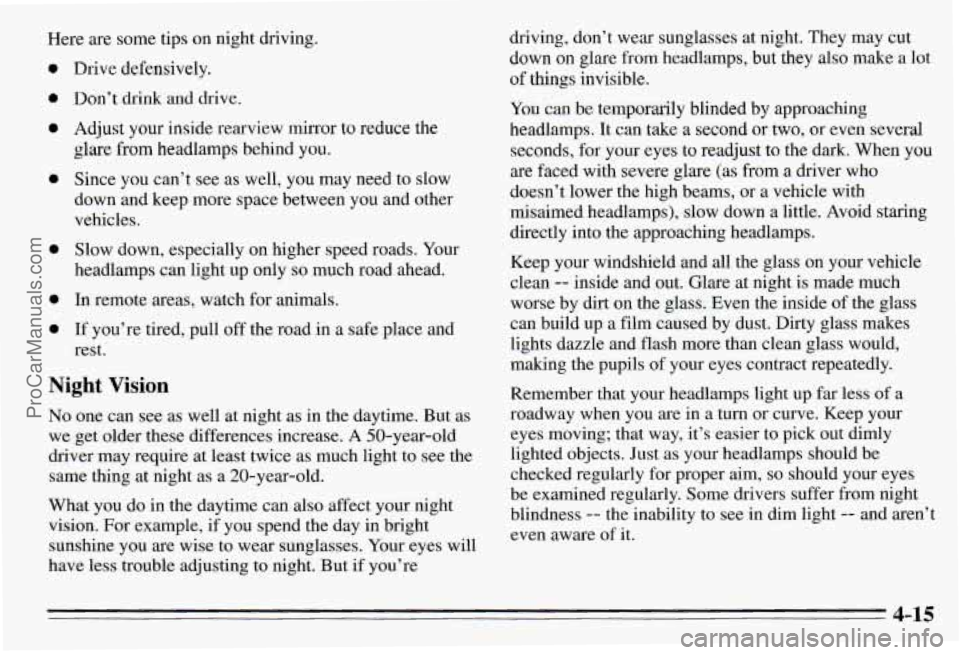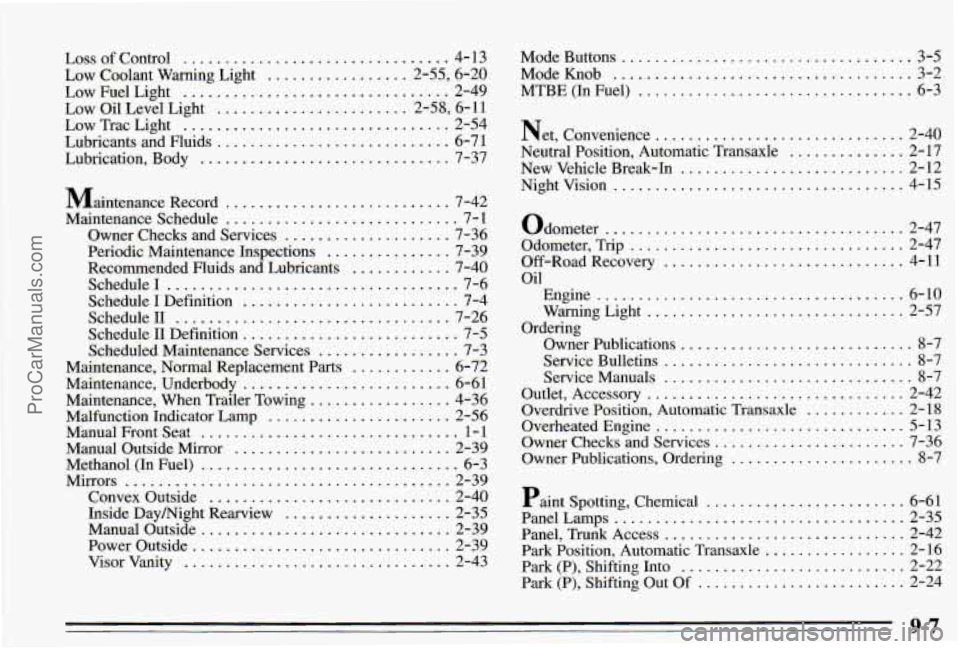1995 PONTIAC PONTIAC night vision
[x] Cancel search: night visionPage 157 of 354

If your vehicle starts to slide, ease your foot off the
accelerator pedal and quickly steer the way you want
the vehicle to go.
If you start steering quickly enough,
your vehicle may straighten out. Always be ready for a
second skid if it occurs. control. Push the brake pedal down steadily when you
have
to stop suddenly.
As long as the wheels are rolling,
you will have steering control.
Driving at Night
Of course, traction is reduced when water, snow, ice,
gravel, or other material
is on the road. For safety, you’ll
want to slow down and adjust your driving to these
conditions. It is important
to slow down on slippery
surfaces because stopping distance will be longer and
vehicle control more limited.
While driving on a surface with reduced traction, try your best
to avoid sudden steering, acceleration, or
braking (including engine braking by shifting to
a lower
gear). Any sudden changes could cause the tires to
slide. You may not realize the surface is slippery until
your vehicle
is skidding. Learn to recognize warning
clues
-- such as enough water, ice or packed snow on
the road to
make a “mirrored surface” -- and slow
down when you have any doubt.
Lf you have the anti-lock braking system, remember: It
helps avoid only the braking skid. If you do not have
anti-lock, then in a braking
skid (where the wheels are
no longer rolling), release enough pressure on the brakes
to get the wheels rolling again. This restores steering Night driving is more dangerous than day driving. One
reason is that some drivers
are likely to be impaired -- by
alcohol or drugs, with night vision problems, or by
fatigue.
4-14
ProCarManuals.com
Page 158 of 354

Here are some tips on night driving.
a
e
a
a
a
e
a
Drive defensively.
Don’t drink and drive,
Adjust your inside rearview mirror
to reduce the
glare from headlamps behind you.
Since you can’t see as well, you may need to slow
down and keep more space between you and other
vehicles.
Slow down, especially on higher speed roads. Your
headlamps can light up only
so much road ahead.
In remote areas, watch for animals.
If you’re tired, pull off the road in a safe place and
rest.
Night Vision
No one can see as well at night as in the daytime. But as
we get older these differences increase. A 50-year-old
driver may require at least twice as much light to see the
same thing at night as a 20-year-old.
What you do in the daytime can also affect your night
vision. For example, if you spend the day in bright
sunshine you
are wise to wear sunglasses. Your eyes will
have less trouble adjusting to night. But if you’re driving, don’t wear sunglasses at night. They may
cut
down on glare from headlamps, but they also make a lot
of
things invisible.
You can
be temporarily blinded by approaching
headlamps. It can take
a second or two, or even several
seconds,
for your eyes to readjust to the dark. When you
are faced with severe glare (as
from a driver who
doesn’t lower the high beams, or a vehicle with
misaimed headlamps), slow down a little. Avoid staring
directly into the approaching headlamps.
Keep your windshield and all the glass on your vehicle clean
-- inside and out. Glare at night is made much
worse by dirt on the glass. Even the inside
of the glass
can build up a film caused by dust. Dirty glass makes
lights dazzle and flash more than clean glass would,
making the pupils of your eyes contract repeatedly.
Remember that your headlamps light
up far less of a
roadway when you are in a turn or curve. Keep your
eyes moving; that way, it’s easier to pick out dimly
lighted objects. Just as your headlamps should be
checked regularly for proper aim,
so should your eyes
be examined regularly. Some drivers suffer from night
blindness
-- the inability to see in dim light -- and aren’t
even aware
of it.
4-15
ProCarManuals.com
Page 348 of 354

Loss of Control ................................ 4- 13
Low Coolant Warning Light ................. 2.55. 6.20
Low
Oil Level Light ....................... 2.58. 6.11
Low Trac Light
................................ 2-54
Lubricants and Fluids
............................ 6-71
Lubrication. Body .............................. 7-37
Maintenance Record
........................... 7-42
Maintenance Schedule
............................ 7- 1
Owner Checks and Services .................... 7-36
Periodic Maintenance Inspections
............... 7-39
Recommended Fluids and Lubricants
............ 7-40
Schedule1
................................... 7-6
Schedule
I Definition .......................... 7-4
ScheduleII
................................. 7-26
Schedule
II Definition .......................... 7-5
Scheduled Maintenance Services
................. 7-3
Maintenance, Normal Replacement Parts ............ 6-72
Maintenance, Underbody
......................... 6-6 1
Maintenance, When Trailer Towing
................. 4-36
Malfunction Indicator Lamp
...................... 2-56
Manual Front Seat
............................... 1 - 1
Manual Outside Mirror .......................... 2-39
Methanol
(In Fuel) ............................... 6-3
Mirrors
....................................... 2-39
Convex Outside
............................. 2-40
Inside DayNight Rearview
.................... 2-35
Manual Outside
.............................. 2-39
Power Outside
............................... 2-39
Visor Vanity
................................ 2-43
LowFuelLight
................................ 2-49
Mode Buttons
................................... 3-5
ModeKnob
.................................... 3-2
MTBE (In Fuel)
................................. 6-3
Net, Convenience .............................. 2-40
Neutral Position, Automatic Transaxle
.............. 2-17
New Vehicle Break-In
........................... 2-12
Nightvision ................................... 4-15
Odometer
.................................... 2-47
Odometer, Trip
................................. 2-47
Off-Road Recovery
............................. 4-11
Oil
Engine
..................................... 6-10
Warning Light
............................... 2-57
Owner Publications
............................ 8-7
Service Bulletins
.............................. 8-7
Service
Manuals .............................. 8-7
Outlet, Accessory
............................... 2-42
Overdrive Position, Automatic Transaxle
............ 2-18
Overheated Engine .............................. 5-13
Owner Checks and Services
....................... 7-36
Owner Publications, Ordering
...................... 8-7
Paint Spotting, Chemical
........................ 6-61
Panel,
Trunk Access ............................. 2-42
Park Position, Automatic Transaxle
................. 2-16
Park (P), Shifting Into
........................... 2-22
Ordering
PanelLamps
................................... 2-35
Park (P), Shifting Out Of
......................... 2-24
9-7 ProCarManuals.com
Page 352 of 354

TopStrap ..................................... 1-39
Torque. WheelNut
.............................. 5-29
Towing a Trailer
................................ 4-29
Towing Your Vehicle
............................. 5-7
Trailer Tongue Weight ........................... 4-3 1
TrailerTowing
................................. 4-29
Brakes
..................................... 4-33
Driving
on Grades ............................ 4-35
Driving
with a Trailer ......................... 4-33
Hitches
.................................... 4-32
Maintenance
................................ 4-36
Parking on Hills
............................. 4-35
SafetyChains
............................... 4-32
Total Weight on Your Vehicle’s Tires
............. 4-31
Turnsignals
................................ 4-34
Weight
of a Trailer ........................... 4-30
Transaxle Fluid. Automatie
....................... 6- 16
Trip Computer ................................. 2-59
Trip Odometer
................................. 2-47
Trip. Before Leaving on a Long
.................... 4-20
Tivnk Access Panel
............................. 2-42
Trunk Release. Remote
........................... 2-8
Turn Signal and Lane Change Indicator
............. 2-29
Turn SignaVMultifunction Lever
................... 2-28
Turn Signals When Towing a Trailer
................ 4-34
TorqueLock
................................... 2-24
TmnkLock
..................................... 2-8
Underbody Flushing
........................... 7-38
Underbody Maintenance
......................... 6-6 1
valves. Coolant Air Bleed ....................... 5-20
Vehicle Damage Warnings .......................... iv
Vehicle Identification Number (VIN)
............... 6-63
Vehicle Loading ................................ 4-27
Vehicle Storage
................................ 6-28
Vehicle. Control
of A ............................. 4-5
Vehicle. Leaving Your
............................ 2-4
Vehicles First Sold in Canada
u
Ventilation ..................................... 3-3
Ventilation System. Flow-Through
.................. 3-4
Ventilation Tips
................................. 3-4
VIN ......................................... 6-63
Vehicle Symbols
................................... v
.. ........................
Vision. Night .................................. 4-15
Visor Vanity
Mirrors ............................ 2-43
Visors.
Sun .................................... 2-43
warning Devices
............................... 5-2
Warning Flashers. Hazard
......................... 5-1
Warning Lights. Gages and Indicators
............... 2-48
Washer Fluid. Windshield
........................ 6-24
Washers. Windshield
............................ 2-30
Washing Your Vehicle
........................... 6-59
Water. Driving Through Deep Standing
............. 2-14
Wheel Alignment ............................... 6-52
WheelNutTorque
.............................. 5-29
Wheel Replacement
............................. 6-52
Wheel Replacement. Used
........................ 6-53
WindowLock
.................................. 2-27
Weatherstrips
.................................. 6-58
9-1 1 ProCarManuals.com